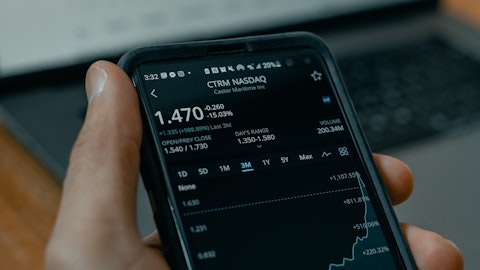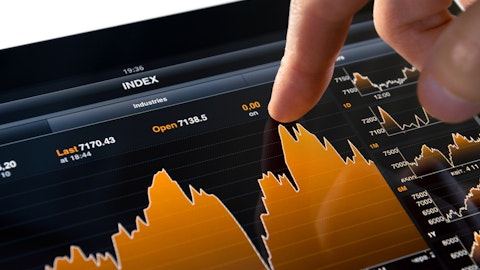Ares Capital Corporation (NASDAQ:ARCC) Q1 2023 Earnings Call Transcript April 25, 2023
Ares Capital Corporation misses on earnings expectations. Reported EPS is $0.57 EPS, expectations were $0.59.
Operator: Good morning. Welcome to Ares Capital Corporation’s First Quarter March 31, 2023 Earnings Conference Call. . As a reminder, this conference is being recorded on today, Tuesday, April 25, 2023. I will now turn the call over to Mr. John Stilmar, Managing Director of Ares Investor Relations.
John Stilmar: Thank you. Let me start with some important reminders. Comments made during the course of this conference call and webcast as well as the accompanying documents contain forward-looking statements and are subject to risks and uncertainties. The company’s actual results could differ materially from those expressed in such forward-looking statements for any reason, excluding those listed in its SEC filings. Ares Capital Corporation assumes no obligation to update any such forward-looking statements. Please also note that past performance or market information is not a guarantee of future results. During this conference call, the company may discuss certain non-GAAP measures as defined by SEC Regulation G, which include core earnings per share or core EPS.
The company believes that core EPS provides useful information to investors regarding financial performance because it’s 1 method the company uses to measure its financial condition and results of operation. A reconciliation of core EPS to basic and diluted net income per share, the most directly comparable GAAP financial measure can be found in the accompanying slide presentation for this call. In addition, reconciliation of these measures may also be found in our earnings press release filed with the SEC this morning on Form 8-K. Certain information discussed in this conference call and the accompanying slide presentation, including information related to portfolio companies, was derived from third-party sources and has not been independently verified.
And accordingly, the company makes no representation or warranty with respect to this information. The company’s first quarter March 31, 2023 earnings presentation can be found on the company’s website at www.arescapitalcorp.com by clicking on the First Quarter 2023 Earnings Presentation link on the home page of its Investor Resources section. Ares Capital Corporation’s earnings release and Form 10-K are also available on the company’s website. I’d like to now turn the call over to Mr. Kipp DeVeer, Ares Capital Corporation’s Chief Executive Officer.
Kipp DeVeer: Thanks a lot, John. Hello, everyone, and thanks for joining our earnings call today. I’m here with our Co-Presidents, Mitch Goldstein and Cort Schnabel, our Chief Financial Officer, Penni Roll; our Chief Operating Officer, Jana Markowitz and other members of the management team. I’d like to start the call by highlighting our first quarter results and then provide some additional thoughts on the economic backdrop and the market. This morning, we reported strong first quarter results. Our core earnings per share of $0.57 increased 36% year-over-year, primarily driven by the benefit of higher interest rates on new investments. On a GAAP basis, our earnings per share of $0.52 and per share for the first quarter was driven by our strong core earnings and the relative stability in the value of our investments this quarter.
Both our core and GAAP earnings were well in excess of our regular quarterly dividend of $0.48 per share, which led to modest growth in NAV per share to $18.45. We’re pleased with the results this quarter, especially when considering the relatively slow transaction environment. The first quarter saw a fair amount of market volatility driven by the uncertain direction of the economy that was certainly exacerbated by the recent turmoil in the banking system. We believe that the banks remain constrained on new activity due to concerns regarding both capital and liquidity and which we believe makes our broad range of flexible capital solutions even more valuable. We feel that the current environment is similar to a number of prior periods of market dislocation that have improved the opportunity set for direct lenders.
The current illustration of these dynamics is highlighted by the fact that 95% of the first quarter LBO financing new issuance was completed by private capital providers, a market traditionally weighted towards the broadly syndicated channel. Where Ares Capital, similar periods of disruption have historically led to increased market share, profitability and NAV growth for the company. Our strong market position is in part driven by the breadth of our origination capabilities and the experience of our team. Since ARCC’s IPO in 2004, we Ares management has continued to invest in the quality and growth of our direct lending platform focused on both sponsored and non-sponsored companies. And besides having what we believe is the largest U.S. direct lending team in the market, with 170 professionals across the U.S., we’ve also built deep industry expertise in areas like software, specialty health care, financial services, consumer, sports, media and entertainment and Power and Project Finance.
We believe that the scale and experience of our team positions us to be even more meaningful with more than 440 sponsors that we’ve transacted with and to further build upon the 250 nonsponsored borrowers that we’ve financed and are nearly 20 years as a public company. To this end, we’ve already seen a 14% quarter-over-quarter increase in the number of deals we evaluated during Q1, and this deal flow represents a broad set of industries. By seeing the largest set of investment opportunities, we are able to make what we believe are the best relative value decisions when committing capital. Our selectivity rate remains consistently low through cycles and is even lower as we take market share through volatile periods. In terms of the new deal flow, our selectivity rate on new transactions in the first quarter is one of the lowest in 5 years.
The merits of our investment — of our origination strategy and our rigorous focus on credit quality allows us to continue to invest in high free cash flow and recession-resilient businesses, and this supports our strong overall credit performance. Despite the more challenging market backdrop, the overall growth and profitability of our borrowers continues to be healthy with a year-over-year weighted average EBITDA growth rate of 8%. This is in line with our portfolio company EBITDA growth rate experienced over the past decade. Additionally, the percentage of our portfolio that we believe is highly impacted by inflation remains consistent quarter-over-quarter and at managed levels today. With respect to nonaccruals, despite increasing modestly this quarter, our nonaccrual rate is meaningfully below our 15-year historical average and is substantially below the historical KBW BDC average for the same time through year-end 2022.

Rawpixel.com/Shutterstock.com
Our portfolio quality is also reinforced by the substantial amount of equity invested in our companies, most often by large and well-established private equity firms. At the end of the first quarter, the weighted average loan to value in the portfolio, including that through our junior loan investments was only 43%, which we believe gives us strong downside protection on our loans. We do have an expectation that a slowing economy will create more stress in the portfolio, along with the rest of the credit markets broadly. Through our nearly 2 decades of operating ARCC, we have a time-tested playbook for successfully navigating periods of volatility and market cycles. In collaboration with our core investment teams, our portfolio management professionals focus on identifying problems early and developing strategies to maximize our outcomes.
These capabilities are central to our ability to deliver our industry-leading track record for credit performance since inception. Which includes generating a 1% annualized net realized gain rate in excess of losses on our investment since inception. This means that along with generating gains on many of our investments, we have also successfully minimized losses in the portfolio in more difficult times. Underpinning our ability to navigate, these periods of volatility is the strength of our balance sheet. We deleveraged during the first quarter, and we ended the quarter with a net debt-to-equity ratio below 1.1x. We also bolstered our level of liquidity post quarter end by increasing or proactively extending out the maturities on over $4.5 billion of committed bank funding at relatively attractive pricing and terms, which is a noteworthy accomplishment given the recent banking turmoil.
This highlights our broad relationships with our banking partners, which we believe will become even more valuable as banks become incrementally more selective. And with that, let me turn the call over to Penni, who will provide some more details on our financial results and some further thoughts on the balance sheet.
Penelope Roll: Thanks, Kipp. For the first quarter of 2023, we had core earnings per share of $0.57 compared to $0.63 in the prior quarter and $0.42 in the first quarter of 2022. We continue to see the benefits of the higher base rates on our predominantly floating rate portfolio in the first quarter of 2023 as our interest and dividend income increased from both the prior quarter and the first quarter of the prior year. This higher interest and dividend income in the first quarter was partially offset by lower capital structuring fees given the slower origination environment. On a GAAP basis, we reported GAAP net income per share of $0.52 for the first quarter of 2023 compared to $0.34 in the prior quarter and $0.44 in the first quarter of 2022.
Our higher GAAP net income per share in the first quarter of 2023 benefited from relatively stable portfolio values during the quarter. Our stockholders’ equity ended the quarter at over $10 billion or $18.45 per share compared to $9.6 billion or $18.40 per share at the end of the prior quarter. Our total portfolio at fair value at the end of the quarter was $21.1 billion, down from $21.8 billion at the end of the fourth quarter, reflecting net repayments and sales from the portfolio. The weighted average yield on our debt and other income-producing securities at amortized cost was 12% at March 31, 2023, which increased from 11.6% at December 31, 2022, and 8.9% at March 31, 2022. The weighted average yield on total investments at amortized cost was 10.8%, which increased from 10.5% at December 31, 2022, and 8.1% at March 31, 2022.
The yields on our portfolio reflect the continued increases in interest rates. Shifting to our capitalization and liquidity. We ended the fourth quarter with a debt-to-equity ratio net of available cash of 1.09x as compared to 1.26x a quarter ago, reflecting net repayments and sales from the portfolio as well as the incremental accretive equity raises totaling $477 million that we did during the quarter. Our liquidity position remains strong with approximately $4.9 billion of total available liquidity, including available cash and also pro forma for our post quarter end debt capital activities. Since the beginning of this year through today, we have remained very active in ensuring we continue to maintain what we believe is a best-in-class capital structure by extending approximately $4.6 billion of revolving debt commitments, which includes increased commitments of over $200 million.
These extended maturities increased the weighted average duration of our secured revolving credit facilities from 3.6 years at March 31, 2023 to 4.3 years today. We are very appreciative for the support we have received from all of our capital providers whose continued long-term commitment to ARCC are one of our key competitive advantages. We believe our increased and significant amount of dry powder positions us well to continue to support our existing portfolio company commitments as well as investing in new opportunities in the current investing environment. With respect to our dividends, we declared a second quarter 2023 dividend of $0.48 per share. This dividend is payable on June 30, 2023, to stockholders of record on June 15, 2023, and is consistent with our first quarter 2023 dividend.
We continue to consider our taxable income and the amount of spillover when set an overall dividend. Our current estimate of undistributed taxable income sometimes referred to as our spillover. At year-end 2022 is $650 million or approximately $1.19 per share. This 2022 spillover level is nearly 2.5x greater than our current regular quarterly dividend rate. We continue to believe that having a healthy level of spillover income is beneficial to the long-term stability of our dividend. We will continue to monitor our undistributed earnings and balance these levels against prudent capital management considerations. And with that, I would like to turn the call over to Mitch to walk through our investment activities for the quarter.
Mitchell Goldstein: Thanks, Penni. I’m going to spend a few minutes providing more details on our investment and portfolio performance for the quarter and then provide an update on our post-quarter end activity and our backlog and pipeline. During the first quarter, we funded $1.1 billion of new investments across more than 30 transactions, primarily in resilient service industries as middle market sponsors and businesses continue to value Ares as a consistent and reliable source of capital, underscoring the breadth of our coverage to the EBITDA for the companies we financed in the quarter, range from approximately $20 million to over $400 million. As a result of the constrained capital environment, the competitive dynamics and risk reward environment continues to be as attractive as we have seen in quite some time.
Market lending spreads continue to be approximately 100 basis points higher year-over-year with historically strong lending documents alongside lower leverage levels. Specifically, our new first lien loan investments in the quarter had a weighted average yield in excess of 11%, and we’re levered less than 4x debt to EBITDA. Additionally, we wera a lead arranger on 85% of our originations in the first quarter. The ability to lead transactions is an important benefit of scale that we provide to our trusted relationships and borrowers. We believe being lead provides us greater control over capital structures, pricing and documents and longer-term better tools to drive successful credit outcomes. Even though the new deal activity remains slow, we believe the size and quality of our incumbent portfolio drives differentiated access to attractive investments.
As we have often said, we benefit from originations where we have incumbent relationships, and this quarter was no different as over 80% of our transactions were to existing borrowers. The breadth of our investment portfolio provides a compelling opportunity to invest in what we believe are our strongest companies. We believe the portfolio continues to perform well and remains defensively positioned due to our long-standing focus on market-leading companies with high free cash flows in what we believe are resilient industries. We have also emphasized portfolio diversification, which reduces the single name risk in the portfolio. Our $21.1 billion portfolio at fair value is diversified across 466 companies and 25 different industries. This means that any single investment accounts for just 0.2% of the portfolio on average and our largest investment in any single company, excluding SDLP and Ivy Hill is just 2% of the portfolio.
Our portfolio also benefits from its weighting toward larger borrowers. The weighted average EBITDA of our portfolio was $294 million at the end of the first quarter, and that is up from $275 million last quarter and $173 million last year. The quarterly increase was largely driven by the organic growth and M&A activity in our portfolio companies and further underscores the momentum from our upper middle market companies. While we maintain broad coverage of the entire market, recently, we have focused on companies in excess of $50 million in EBITDA, and we believe that positioning pays off in its performance. Companies in our portfolio with EBITDA in excess of $50 million are growing faster than companies with less than $50 million of EBITDA.
The resulting health of the portfolio is demonstrated by our stable weighted average portfolio grade of 3.1 and our collection of 99% of contractual interest from our portfolio during the first quarter. While our portfolio companies are not immune to the inflationary environment. As Kipp described, the percentage of the portfolio we estimate that is highly impacted by inflationary risk remains at manageable levels of between 5% and 10% of the portfolio. It is important to note that we have minimal to no exposure to many sectors that are highly impacted by inflation that remain prominent in the broadly syndicated loan market. Industries such as packaging and paper, capital goods, gaming, and chemicals, were highlighted by a recent credit research note as being heavily impacted by rising input costs, but we have consciously underweighted these industries.
Our nonaccrual rates continue to be well below historical levels. Our nonaccrual rate at costs picked up modestly to 2.3% from 1.7% last quarter but remains well below our 3% 15-year history average and the KBW BDC average of 3.8% at the same time through year-end 2022. Finally, I will provide a brief update on our post-quarter end investment activity and pipeline. From April 1 through April 19, 2023, we made new investment commitments totaling 369 million of which 311 million were funded. We exited or were repaid on 397 million of investment commitment. As of April 19, our backlog and pipeline stood at roughly 500 million. Our backlog and pipeline contains investments that are subject to approvals and documentation and may not close or we may sell a portion of these investments post closing.
While it has been a pretty slow start to the year, even for the typically seasonally slow first quarter, we do think that things should pick up in regular course. I will now turn the call back over to Kipp for some closing remarks.
Kipp DeVeer: Thanks, Mitch. In conclusion, we are monitoring the potential for economic challenges that may lie ahead, but we believe that we are well positioned to navigate these conditions. Our team has an approximately 20-year history together, managing assets in a variety of economic situations as a public company. Our confidence is supportive by what we believe are our many long-term competitive investing advantages, the strength of our balance sheet and the defensive positioning of the current portfolio. In addition to these advantages, the tightening availability of corporate credit from the banks and the liquid capital markets is only enhancing our competitive position. We believe that our ability to deliver a flexible capital solution with scale and certainty leaves Ares Capital well positioned to continue to grow share in a challenging yet expanding market opportunity.
As always, we appreciate you all joining us today, and we look forward to speaking with you next quarter. And with that, operator, we can open the line for questions.
See also 25 Most Exclusive Luxury Brands in the World and 12 Most Promising Healthcare Stocks.
Q&A Session
Follow Ares Capital Corp (NASDAQ:ARCC)
Follow Ares Capital Corp (NASDAQ:ARCC)
Operator: . Our first question comes from the line of John Hecht with Jefferies.
John Hecht: Just first one is obviously, how are you benefiting from a rising rate environment and the forward curve suggests that things may change in the course of the next few quarters. Do you — is there anything you guys can do whether it’s kind of liability structuring or even a hedging of some type or you can try to kind of protect yourself in a declining rate environment?
Kipp DeVeer: Yes. I mean, I’m looking at Penni, and I’ll give you my opening answer, which is we’ve tried to have a mix of, obviously, senior and unsecured both floating rate and fixed rate liabilities, John. So having sort of a balanced view of how we want to construct the liability side of it. But on the hedging front, there’s not a tremendous amount we can do that’s particularly economic today, right? The cost of hedging is pretty high. And yes, I take your point. Look, we do a lot of modeling forward on the company. And one of the things that we notice is the LIBOR curve tends to move around a lot and often. So, it’s something that we’re keeping our eye on, but I don’t think there’s a lot we can do about it today, unfortunately.
John Hecht: Okay. That’s helpful. And then — just looking — I mean, obviously, you talked about your EBITDA trends. You mentioned you noted a little bit of flows within your nonperforming asset buckets. I mean, but it seems — I mean are you seeing anything that suggests there’s a shift going on. I mean, I know you guys have been generally defensive in your industries anyways. But even like all else equal, are you seeing any shifts at this point or just sort of preparing for what might be coming generally speaking?
Kipp DeVeer: Yes. I mean I think we’re cautious. The question that I’m getting that we’re all getting a lot is, how does credit quality in the portfolio look today? And the answer that I’ve given in most of the meetings that we’ve done before this call today has been, if you look at the overall credit metrics in the portfolio, they’re actually quite strong today, right? You’re seeing year-over-year EBITDA growth. You’re seeing good interest coverage, you’re seeing nonaccruals that are below historical averages. Again, when we look at the weighting of the portfolio in our 1s and 2s, which are the weaker names. It’s come down substantially since COVID. So all the credit metrics today are actually quite good. Does that mean that we think everything’s rosy and the remainder of the year is going to be not a little bit bumpy, No, I think we’re preparing for a slower economy.
And the fact that companies have higher debt service costs because of the base rate environment. So — but today, as we sit here on the call, the credit metrics are holding up quite well.
Operator: Our next question comes from the line of Finian O’Shea with Wells Fargo.
Finian O’Shea: Hi, everyone. Good morning. On the opportunity for upping lending terms to market via add-ons or amendments, I think you touched on that. What portion of the portfolio would reflect the economics of the more recent environment?
Kipp DeVeer: I’m not sure I have that number off the top of my head there. Fin, I mean, look, the reality is when you’re doing incrementals and add-ons to existing deals, and I’m looking at credit, it tends to be small relative to what’s outstanding, right? So a bigger driver will be, frankly, I think, amendments on entire tranches is something that perhaps isn’t performing as expected. So I don’t know offhand. I’d have to guess it’s 10% to 20% of the portfolio may be, but it’s really just a guess. I mean, , you can chime in with some thoughts.
Unidentified Company Representative: I might guess it could be a little bit higher because you have to remember, even if we provide an incremental that is somewhat small, we have MFN protections in a lot of our documents that allow us to reprice our existing tranches to current market environment despite the fact that we’re only providing some small incremental capital. So that’s a nice effective tool. To bring the portfolio up to market. So maybe it’s a little bit higher, Ken.





